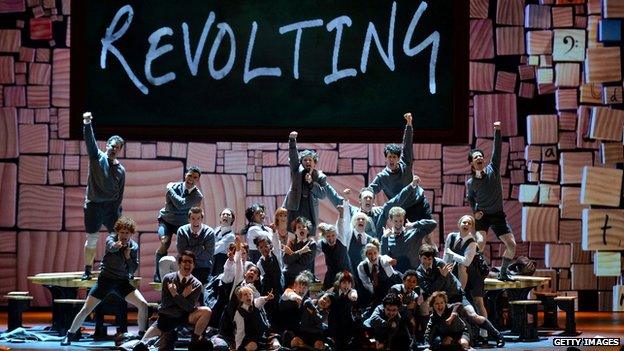The state of UK theatre: In numbers
- Published
jonathankeenan.jpg)
Hope Place, a new play by Michael Wynne, was staged at the new Liverpool Everyman last year
How healthy is British theatre? One snapshot provided by BBC research suggests the number of plays staged by British subsidised theatres rose between 2009 and 2014. This breakdown gives further information.
Read the full story about the findings here and a further analysis here. Full statistics, as well as the definitions and criteria used, can be found below.
The research compared the levels of full professional productions and co-productions staged by 62 UK subsidised theatres in 2009 and 2014.
By size of theatre company government grant
By theatre location
Full professional productions were defined as those which lasted at least an hour and ran for at least a week, and did not include youth, community or amateur productions.
Where two or more theatre companies worked together to co-produce a show, duplicate productions were removed from the list so each show was counted once. The relevant totals were adjusted appropriately.
Productions staged by the selected theatres were counted if they opened at any venue in 2009 and 2014 - including transfers and tours that began in those years.
Where a number of shorter plays were staged together, for example a double bill of one-act plays performed in the same evening, this has been counted as a single production.
New plays were defined as shows which had their UK premieres in these calendar years. They include brand new scripts, devised work and stage adaptations of books and films. The term "new play" was used as a convenient catch-all term to cover all plays, musicals, children's shows and dance theatre.
The definition of new plays became more tricky when looking at new adaptations or translations of existing theatre scripts. In this case, an attempt was made to count plays that were comprehensively rewritten or updated.
By size of theatre company grant
By theatre location

The following breakdown provides information for each theatre analysed for the BBC research.
It is not possible to read too much into these individual breakdowns. Levels at an individual company can fluctuate, there may be reasons for specific changes, and a company may do other work that is not counted as a full production for these purposes.
But the bigger picture can be gained by looking at these figures together.
NB: One of the National's three auditoria was closed for refurbishment for most of 2014, and was replaced by a temporary venue, The Shed, which was dedicated to new theatre.
NB: The RSC's two normal theatres were closed for refurbishment in 2009, and were replaced by one temporary venue, The Courtyard.
NB: The National Theatre of Scotland's production levels have grown over time since its birth in 2006. Also, in 2009, the company produced eight community productions, which have not been counted. In 2014, Dear Scotland used 20 writers - hence the rise in that category.
NB: The Traverse also puts on a particularly high number of new plays that have short running times and short runs, and therefore have not been counted.
NB: Contact makes and stages a range of experimental shows for a youth audience, many of which did not meet the criteria for full productions for these purposes.
NB: In 2009, The Tricycle staged two major projects. The Great Game consisted of 12 short plays by 12 writers that were performed in three sets of four. Therefore these have been counted as the equivalent of three full productions. Not Black and White consisted of three full-length productions.
NB: Battersea Arts Centre puts on a range of cutting-edge work, some of which did not meet the criteria for full productions for these purposes.
- Published4 February 2015

- Published4 February 2015

- Published4 February 2015
